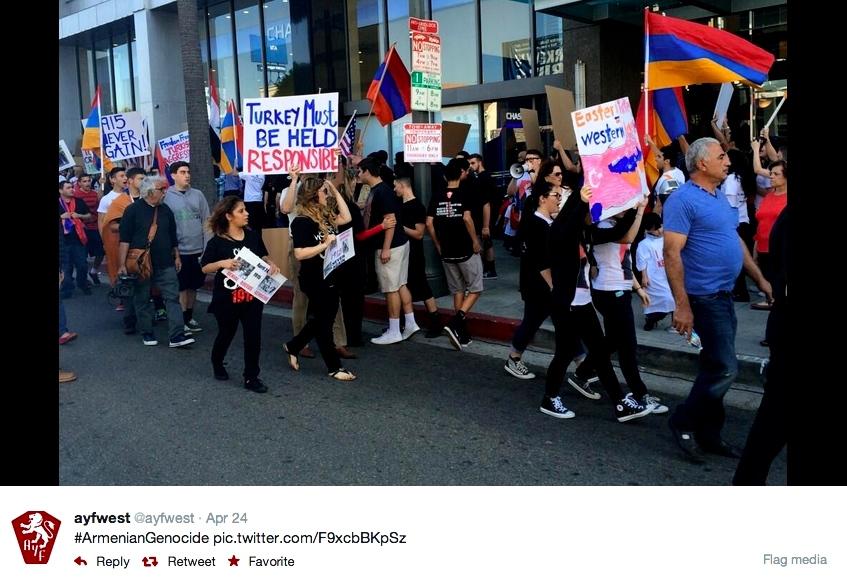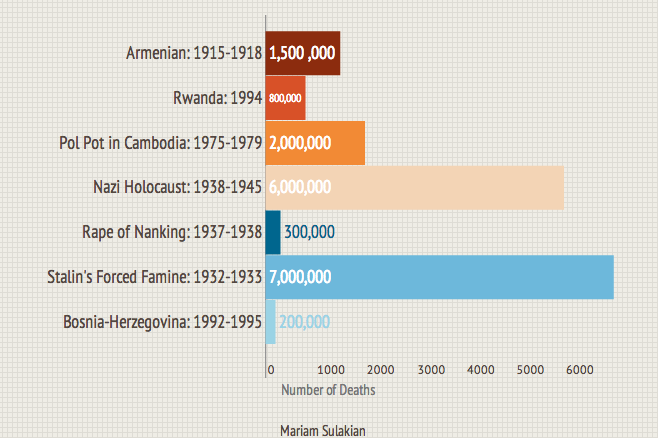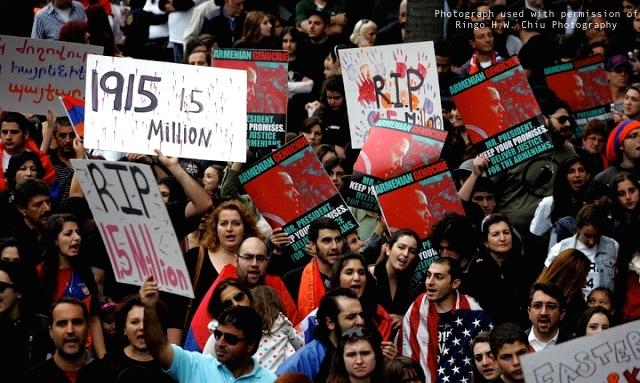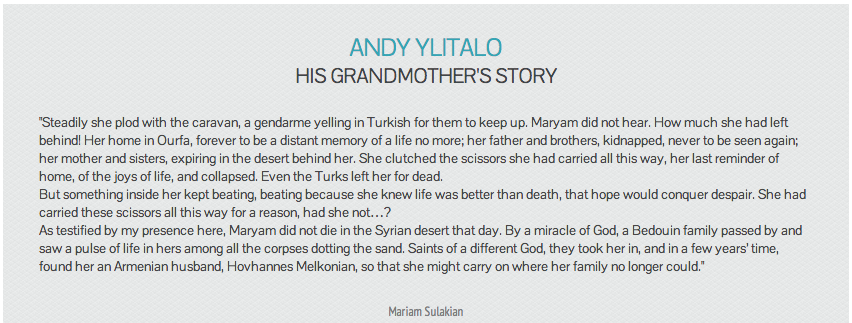Los Angeles students commemorate the Armenian Genocide
AYF hosts protest to mark 99th anniversary of the Genocide
April 26, 2014
In commemoration of the 99th anniversary of the Armenian Genocide, the Armenian Youth Federation (AYF) protested in Los Angeles Thursday afternoon to raise awareness and recognition for its cause.
The Armenian Genocide of 1915 refers to the annihilation of 1.5 million Christian Armenians by the Ottoman Empire, present-day Republic of Turkey. Despite Turkey’s reluctance to acknowledge the atrocity, recognition has triumphed in 21 countries and 42 of 50 U.S. states, including California, which recognizes April 24 as Genocide Remembrance Day.

“It is my responsibility as a human being to demand justice…and ultimately accountability to the perpetrators of the Genocide in order to prevent atrocities like the Armenian Genocide,” protester and University of Southern California graduate Karine Bagdasaryan said. “The world, and most importantly the Turkish government, need to know that we will never forget, and we refuse to let this crime against humanity go unpunished.”
The AYF’s “24 Hours of Action” began at 2 p.m. Thursday and terminated the same time Friday afternoon for “the 99th year of continued denial of the Armenian Genocide by the Republic of Turkey and the United States of America,” according to the AYF page.
The demonstrators, numbering in the thousands, assembled towards the Turkish Consulate in L.A. for their annual protest. For further support, the AYF created a Facebook event outlining the schedule for the day, including busing times and locations for those interested in joining the public presentation.
Protestors at the event constituted mainly people of Armenian heritage. For some, like Karine, the Genocide directly impacted the lives of their ancestors. Karine’s great-grandparents, survivors of the Genocide, were forced to leave their homes in the cities of Mush and Van to escape the brutality of the extermination. Karine expressed, referencing Martin Luther King, Jr., “Injustice anywhere is a threat to justice everywhere.”
The AYF’s social media pages were updated throughout the 24-hour period to keep the public on track with the scene of events.
Twitter Instagram Facebook Youtube
Commencement of the event began with a two hour period of supplying multilingual pamphlets to the public with information about the Genocide. After another two hours of protest, the AYF hosted a procession of music and artistry symbolizing opposition to the committers of the decimation.
During the eighth hour of protest, Youth members joined together to sing “Leran Lanchin,” a nationalistic song which memorializes fallen heroes.
Video footage by the Armenian Youth Federation (AYF)
Midnight marked the beginning of the protestors’ exhibition of the “Eight Stages of Genocide” by Gregory H. Stanton, President of Genocide Watch. The eight stages represented by Stanton include classification, symbolization, dehumanization, organization, polarization, preparation, extermination, and denial.
The following four hours of demonstrations, preceding the final two hours of protest rallying, served to galvanize support by means of political street theater.
To students like Natalie Simonian (10), who is of Armenian descent, the denial of the Genocide “is deeply disrespectful to the millions of Armenians who lost loved ones,” and hypocritical of the very ideas defended by the United States government.
“The U.S. constantly campaigns for minority freedoms and preaches that all people are equal and should be respected; yet the government conveniently ignores the mass murder of 1.5 million Armenian people,” she said. “The AYF is doing a fantastic job by standing up for their country and their people and demanding justice that is grossly overdue.”
Advocates of the demonstrations were also encouraged to submit a selfie of themselves to 1.5million.net as further means of protest. The web page aimed to collect one and a half million selfies, one for every Armenian massacred in the Genocide. Entries amounted to 479 selfies.
Congresswoman Judy Chu, U.S. Representative for California’s 32nd Congressional District, voiced her own advocation for the Armenian community.
“Those who survived…set roots up somewhere new, and for some, that place is my home community in the Pasadena area,” she said. “I am incredibly privileged to represent an active and vibrant Armenian-American community.”
Video footage by Armenian National Committee of America (ANCA)
According to Rep. Chu, Pasadena will soon home a memorial commemorating the 1.5 million Armenians who perished in the Genocide.
“It’s important for more people to be aware of the Armenian Genocide. Not only does it represent a significant chapter of Armenian history, but it also has pertinence to society at large,” said Suraya Shivji (11), whose mother and brother were present for the protests. “The Armenian Genocide constitutes much of the basis of future foreign relations as well as the Holocaust. I am unsure as to why this massacre is not as widely studied as the Holocaust.”
Although a majority of U.S. states have recognized the Genocide, the federal government still refuses to do so, despite promises made by President Obama during his election campaigns. Protest groups, including students, across the nation have spoken against Obama’s refusal to follow up on his word.
According to the Georgetown Journal of International Affairs, “It is time for Mr. Obama to fulfill his promise to officially recognize the Armenian Genocide as president.”
A “Tell Congress to Recognize the Armenian Genocide” petition asking the President for acknowledgment has accumulated 21,176 signatures out of a goal of 25,000.
Outreach participation for the Armenian Genocide stretched beyond the protester’s arena in L.A. The local St. Andrew’s Apostolic Armenian Church in Cupertino held a commemoration service and invited Stanford University freshman Andy Ylitalo to speak of his grandmother, a survivor of the Genocide.
San Jose State University professor MaryLou Yengoyan noted the connection of awareness to prevention, stating that “people should know about [the genocide] so that another won’t be repeated again.”
Yengoyan later commented on the Genocide’s influence on the Holocaust 18 years later, of which Adolf Hitler allegedly claimed, “After all, who remembers the annihilation of the Armenians.”
Internationally, France was among the countries which held commemoration services, and for the first time, French Armenians were joined by President Francois Hollande in Paris. The Paris protesters paraded in front of the Komitas’ statue in Canada Square.
Next year will mark the 100th anniversary of the 1915 Armenian Genocide. Further background information and concerns regarding the acknowledgment process may be accessed through Recognize the Armenian Genocide, a website instituted to promote awareness for the mass extermination.

 Video footage by PBS
Video footage by PBS


Neal Gulati • Apr 30, 2014 at 12:31 am
Great article Mariam. Definitely the best one you have written so far. Keep up the good work Mares!
Alnoor Shivji • Apr 27, 2014 at 4:48 pm
Fantastic article! Harker is lucky to have you as such a great reporter. Made me wish I was more apart of the Armenian Culture! You highlighted some great points in regards to the Armenian Genocide in the public’s eye.
Cheers!